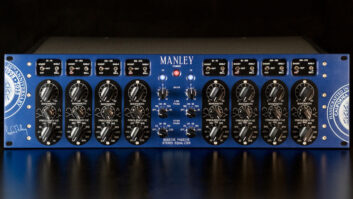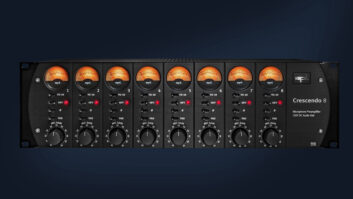
The SLAM! (Stereo Limiter And Mic pre) defies categorization,combining an updated version of Manley’s stalwart ELOP opto-limiterwith a new FET-based brickwall limiter and two Class-A preamps with micand DI inputs. The $6,000 SLAM! is a superanalog approach tolouder-sounding recordings.
UNDER THE HOOD
Construction is to Manley’s excellent standards. There are twoLundahl mic transformers, two more feeding the FET limiter section andfour Manley-made line I/O transformers. Caps are Wima and Multicap; theresistors are mostly 1% metal film; and some two-dozen relays handleaudio switching. The external PS has a large, 16-pin, mil-specconnector. My review unit included the optional $2,500 AnagramTechnologies Quantum AD/DA converter board.
The mic preamp uses a 12AT7 for 99% of the voltage gain with an FETin series with the tube’s cathode. This design self-corrects for driftand tube changes, and capitalizes on the complementary characteristicsof tubes and FETs by canceling out each other’s inherent weaknesses.The new ELOP optical limiter circuit differs from the original ManleyELOP. A conventional op amp and transistor-current amplifier driver areused for better control, wider voltage swings for flatter response andfaster action.
CONTROLS
Below the large, lighted Sifam VUs and ladder LED peak meters areswitches for meter modes, limiter in/out and stereo-linking, and apower switch that’s dangerously close (for Mr. Clumsy here) to theother controls. Although calibrated in 1dB steps, my only wish is thatthe LED meter was twice the size and double the resolution.
The input knob adjusts levels of +4dB line sources and/or the DAC’soutput. This control usually runs straight up at 12 o’clock with±20 dB of range; but for mic or DI sources, it operates like astandard gain knob. Likewise, the output control operates at unity gain(normally around 12 o’clock) and also has a ±20dB range. Unlike amakeup gain control on a compressor, the output does not go to zero forfade outs or muting; it’s more like a master output-level trim.
The ELOP limiter has only a single control: threshold. Fully CW at+26 dB is off, and it ranges to +6 dB. ELOP’s other control is the SC(sidechain) Filter switch. It has three positions: flat (no sidechainfiltering); a 100Hz, 6dB/octave HP filter; and a 200Hz corner frequencyup to 200 Hz that also adds +3 dB at 4 kHz. Great for mixes where hotkick and bass levels would otherwise cause pumping, the 100Hz positionprovides more limiting, better control and makes your mix louder. The200Hz position is best for recording or mixing vocal tracks, and its4kHz boost causes a subtle de-ess action. The 200Hz roll-off allowsmore limiter depth with less-errant gain reductions caused by“P” pops or other LF plosives.
The FET limiter has attack/release/threshold controls. Attack hasthree positions: moderate (10 ms), fast (1 ms) and very fast (0.1 ms).The 11-position release control varies from two seconds to 10 ms.Medium release times in the 50ms to 200ms range provide for maximumloudness. The threshold control ranges from +26 off to +6 dB. Allcontrols on SLAM! are interactive: Every parameter change affects theother settings. Increasing the speed of attack will cause more frequentgain reductions, and overly fast release times can cause LF modulationdistortion; listen before committing to a superfast releasesetting. A clip-release position simulates an overdriven electronicdistortion that could work for guitars or synths.
INS AND OUTS
SLAM! accepts audio from the DAC output (if your unit is equipped);a rear-panel Neutrik Combo jack line input; DI from a dual-impedance,¼-inch rear-panel jack (30 dB more gain than line); and mic (60 dBof gain), with or without polarity flip and/or 100Hz highpassfilter.
One quirk: Both balanced line and mic inputs share the same XLRjack. To prevent accidental application of phantom power to a linesource, the phantom switch is also on the back panel. Other rearconnections include a TRS balanced DAC output, an unbalanced¼-inch -10/ +4dB output jack and two rows (one for each channel)of six TT patchbay jack/inserts. These are send and return paths toboth the opto and FET sections to insert external EQ (or whatever) tothese limiters separately. Other TT jacks let users link multiple unitsfor multichannel or surround audio.
ANAGRAM TECHNOLOGIES QUANTUM CONVERTER
Swiss-based Anagram Technologies’ optional AD/DA converter plugsinto SLAM!’s rear panel and provides digital I/O. The DACasynchronously up-converts a digital signal to 192 kHz using ahigh-speed SHARC DSP chip running 40-bit, floating-point software. Thisresults in near-zero jitter, thus reducing audio “timesmear.” The DAC converter analog output is then routed throughSLAM! for peak limiting and returned to the Quantum ADC, sampled at 192kHz, while a second SHARC down-converts to 44.1/48/88.2/96 kHz. Futuredesigns will include 192kHz capability when the connector issue isfinalized — an easy upgrade, as the converters are alreadyrunning at 192 kHz. User choices include 16/20/24-bit wordlength;dither and noise-shaping on/off (only if you are not 24-bit); WordClock and Super Clock inputs; and three filter settings to“personalize” the sounds.
IN THE STUDIO
Setting up a limiter is more critical and time-consuming than usinga compressor. A lead vocal with 5 dB of limiting can sound louder than10 dB of constant 1.5:1 compression, where the compressor raisesquieter sections but lets fast, distorting peaks hit your A/Dconverter. The limiting ratio of SLAM!’s ELOP goes to a maximum of 10:1and it’s soft-knee- and program/drive-dependent. The FET limiter startsat 5:1 and gradually climbs to 8:1 with a maximum, practicalgain-reduction depth of 15 dB! Because the ELOP can do about 20 dB ofGR, the two combined offer a total gain reduction of 35dB gain.
For all recorded sources, I used tracks and mixes from a ProTools|HD3 rig and a large Nuendo PC. I began with both the ELOP and FETthreshold knobs set to max CW, or +26 dB. I used a 1kHz tone to setinput and input-level controls to 0 dB. The controls are a littletouchy at first, and I wish there were separate bypasses for both theELOP and FET sections.
I used SLAM! on every imaginable audio source. On live kick drums,it’s a godsend. You can record full digital levels and not be concernedwhen the drummer plays a little harder and (normally) goes into digitalclip; the drummer won’t with SLAM! in the way. I used the Medium andFast attacks on drums. The VF setting was so fast that the percussiveedge is rounded off too much. Lower threshold settings and VF work wellfor things like guitars, vocals and bass, although the ELOP sectionusually controls these sources very well without the FET limiter.
I tested the mic preamp section using a Lawson 47 condenser. Withloads of gain, the mic preamp has a lively, open and clean sound withexcellent dynamic range, most noticeable in the quieter and subtlemoments. I was listening to both speaking and singing vocals on-mic.The Lawson’s owner never heard his mic sound so good. He always thoughtit sounded a little muffled, and now considers his regular preamp thereason.
Next, I recorded a 9-foot Yamaha grand piano using two DPA 4011cardioid condensers. I liked the mic preamp’s “tube-y”sound for a round and sweet tone, even on this bright piano.
The ¼-inch DI input is dual-impedance: Plugged all the way in,it’s 100k-ohm; half-way out, it’s 10Meg ohm. My bass player (and I)preferred the 10M position for its more open and clear sound from hisFender P Bass pickups. I used both the ELOP and FET sections to limitthe bass. Wow! I have always had trouble with recording bass (todigital) when the player “slapped” or “popped,”causing immediate overs. Analog tape would take care of these peaks;digital doesn’t. I set the ELOP to clamp most of them without killingthe rest of the performance’s dynamics. At a slower release and a fastattack, the FET section brickwalled the rest.
MASTERING APPS
Full analog-based mixes that you want to be loud benefit the mostfrom using the ELOP and FET together. I use about 2 to 6 dB of ELOPlimiter on certain rock songs (which consist of mostly compressedindividual tracks) and then added up to about 2dB peak limiting fromthe FET. My average loudness came up anywhere from 3 to 7 dB, but mypeak level was about the same: around 1 to 2 dB below digitalfull-scale. I could go hotter, but the filters in ADCs require 1 to 2dB of headroom and you may want your mastering engineer to have someroom to work, too.
Mixes from a Nuendo PC were fed using the Anagram ADC/DAC. Thelimiting process is the same as using the analog inputs, except that Iwas able to take in a session running at 44.1 kHz and output a 96kHzmastered stereo mix. If you output the same rate as the session, thenyou’ll have to use a master word clock. I could add 3 to 6 dB ofloudness and still love the overall sound quality. I could have addedmore, but you start to trade off good music fidelity for just“louder.”
CONCLUSION
SLAM! is the ultimate analog front and back end for any recordingstudio. With the Anagram Quantum option, I could cleanly record trackswith a pair of clear, Class-A mic tube preamps with minimal peaklimiting using the ADC, and then master the final mix using the DAC/ADCpath and the modern-sounding ELOP/FET combo. All of my clients wantthis process for louder mixes, and SLAM! gets there with a gorgeoussound and a minimum of sonic mangling.
Manley Laboratories, 909/627-4256, www.manleylabs.com.
Barry Rudolph is an L.A.-based recording engineer. Visit hisWebsite atwww.barryrudolph.com.







